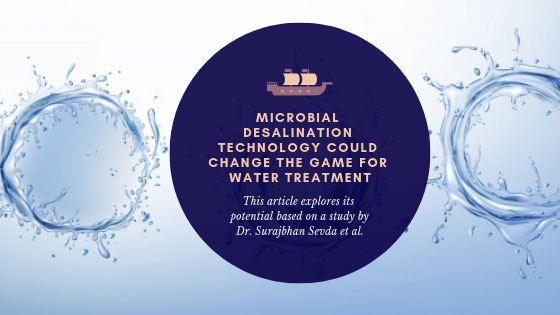Summary:
Today, freshwater has turned endemic with less than 3% available for use. Of the total amount of freshwater on the earth, 67% is inaccessible. This calls for technologies and ways to purify the 97% of saltwater present in the seas so as to quench the thirst of millions around the globe. For the past few years, desalination is garnering attention due to its performance in providing freshwater out of seawater and wastewater. More funds are now being redirected towards research to make it energy efficient and easy to use for the masses. One such technology is the MDCs that can be used to power up the equipment with less wastage of energy. This article explores its potential based on a study by Dr. Surajbhan Sevda et al.
Description:
Desalination technologies are in use for far more purposes than just drinking water. These are used for product application, wastewater treatment, production of solution and more. One other area where this technology is used intensely is for the treatment of petroleum wastewater. Wastewater treatment has been made a must in many countries to keep the environment safe from the harmful contaminants of the rejected water. This water in industrial standards is called brine and contains concentrated levels of salts and chemicals. Which is why negligence towards the wastewater by industries can lead to the cancellation of their license.
The petroleum industry:
Petroleum refinery wastewater (PRW) is considered to be one of the most polluted wastewater from any industry in the world. The concentration of pollutants and the risk to the environment is very high. Because of this, the wastewater from the petroleum industry has to be treated, however, the conventional methods including normal reverse osmosis desalination are energy intensive. And therefore, it has become very crucial to find sustainable solutions for the wastewater problems in the petroleum industry. One such technology that has emerged in recent times is Microbial Desalination cells (MDCs). These have been found to be energy efficient and capable of treating both wastewater and seawater.
What is an MDC?
Microbial Desalination Cell is a biological electrochemical system. Electroactive bacteria are used to power the process of desalination in-situ and resourcing the natural anode and cathode gradient. This creates an internal supercapacitor which proves to be very useful for water treatment.
The MDC technology:
This is a very newly developed and integrated microbial fuel cells with electrodialysis for wastewater treatment, desalination as well as renewable energy production. Due to less energy requirement and eco-friendly technology, this system received a considerable amount of attention from labs all over the world. It is a very sustainable option which can be used as a single option or can be combined with other different ways of wastewater and saltwater treatment like reverse osmosis or electrodialysis. In further advancement of this method, many alterations have been made to the basic technologies and few modified versions of MDCs have been developed. These are Bicathode MDCs, stacked MDCs, and recirculation MDCs.
Promising results:
In a particular research study for PRW, the new MDC technology was used for wastewater treatment and the following results were obtained.
- The MDC achieved the maximum COD removal by simply adding 20 g/L of Sodium Chloride solution.
- The COD removal was further alleviated from 64% to 70.5% by changing the catholyte from phosphate buffer solution (PBS) to acidified water.
- For seawater, the maximum efficiency of 19.9% was obtained with MDC with PBS.
- Acidified water was particularly found to be a very effective catholyte in terms of specific energy production.
- While desalinating seawater, the total energy produced was 32.6 W h/kg COD.
- This research very efficiently displayed that PRWs can be used as an anodic substrate in MDCs for energy generation and seawater desalination.
The end result of this study clearly implied that MDCs can be used successfully for treating petroleum refinery wastewater, to generate electricity, also called bioelectricity and desalinate saltwater.
Technologies like the MDCs are a must in the world today for a sustainable future. More technologies have to be developed which are energy efficient and provide results as achieved from traditional desalination methods. Only then can we begin to live in a world without any harm to the environment and ourselves.
Author’s Bio:
AMPAC USA is a leading manufacturer of advanced reverse osmosis water treatment systems. For over 30 years the company has been providing its customers and clients around the world solutions to their water treatment problems. With years of an impressive track record, AMPAC strives to develop solutions to make reverse osmosis systems, advanced for improved quality and cost efficiency.
References:
https://www.sciencedirect.com/science/article/pii/S0011916415003422










